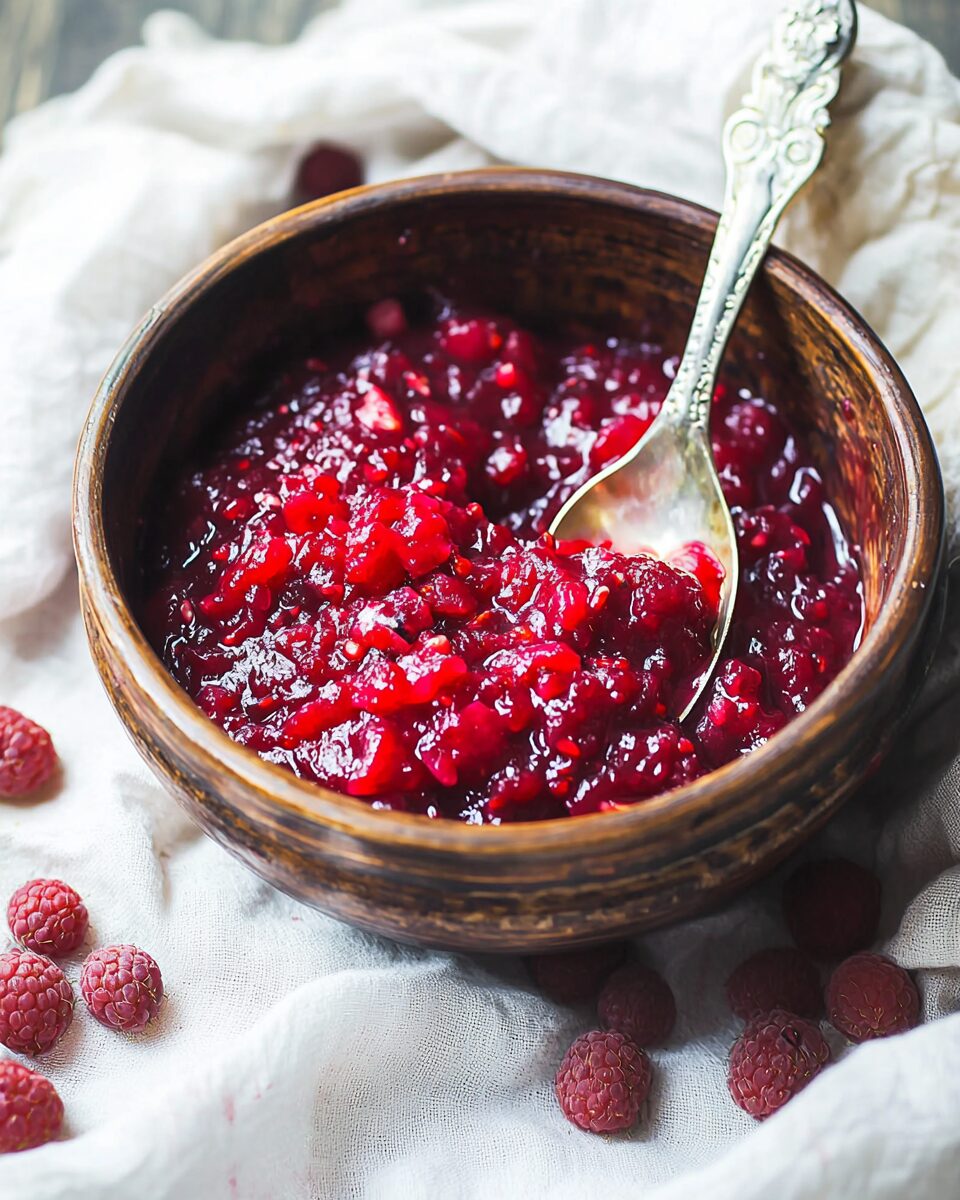This classic rhubarb raspberry compote is a vibrant and tangy-sweet topping that pairs beautifully with yogurt, ice cream, pancakes, or toast. The combination of tart rhubarb and juicy raspberries creates a deliciously balanced flavor, perfect for spring and summer treats.
FULL RECIPE
Ingredients
- 3 cups fresh or frozen rhubarb, chopped
- 1 ½ cups fresh or frozen raspberries
- ½ cup granulated sugar
- ¼ cup water
- 1 tsp lemon juice
- ½ tsp vanilla extract (optional)
Directions
- Combine rhubarb, raspberries, sugar, and water in a medium saucepan.
- Place over medium heat and bring to a gentle boil, stirring occasionally.
- Reduce heat and simmer for 10–15 minutes, or until rhubarb is soft and mixture thickens.
- Stir in lemon juice and vanilla extract, if using.
- Remove from heat and let cool slightly before serving or refrigerating.
- Serve warm or chilled as desired.
Nutritional Information
- Calories: 70
- Carbohydrates: 18g
- Sugars: 16g
- Fiber: 2g
- Fat: 0g
- Protein: <1g
History of Rhubarb Raspberry Compote
Rhubarb and raspberry compote has deep roots in traditional cooking, especially in regions where rhubarb grows abundantly in cooler climates. Historically, rhubarb was prized for its tart flavor and medicinal properties. Combining it with raspberries, which add natural sweetness and a vibrant color, created a well-balanced preserve enjoyed in many European households for centuries.
Seasonality and Freshness
The best time to make rhubarb raspberry compote is during spring and early summer when both fruits are at their peak freshness. Using fresh, in-season rhubarb and raspberries enhances the flavor intensity and ensures the natural sweetness and tartness are perfectly balanced. Frozen fruits can be used year-round but may alter texture slightly.
Nutritional Benefits
Rhubarb is rich in vitamin K, fiber, and antioxidants, while raspberries provide an excellent source of vitamin C, manganese, and dietary fiber. This compote offers a low-calorie way to enjoy the benefits of both fruits, making it a healthy option for a dessert or snack topping.
Flavor Profile
The tartness of rhubarb pairs harmoniously with the sweet, slightly tangy raspberries. This balance creates a complex flavor profile that is both refreshing and comforting. The lemon juice enhances the brightness, while vanilla adds subtle warmth.
Common Uses
Rhubarb raspberry compote is extremely versatile. It can be spooned over breakfast dishes like oatmeal, pancakes, or yogurt, used as a topping for ice cream, mixed into smoothies, or served alongside roasted meats and cheeses for a sweet contrast.
Storage Tips
To maintain freshness, store the compote in an airtight container in the refrigerator for up to one week. It also freezes well, allowing you to preserve the flavors for several months without loss of quality. Thaw slowly in the fridge before use.
Variations and Additions
Many variations of this compote exist. Some add spices like cinnamon or ginger to deepen the flavor, while others incorporate orange zest or fresh herbs such as mint or basil for a unique twist. Sweeteners can be adjusted or replaced with honey, maple syrup, or agave.
Cooking Techniques
Simmering the fruit gently prevents it from breaking down too much, preserving a pleasant texture with visible pieces of rhubarb and raspberry. Adjusting cooking time can create a thinner syrup or a thicker jam-like consistency depending on preference.
Health Considerations
While rhubarb leaves are toxic due to oxalic acid, the stalks used in compote are safe to eat. Moderation is advised for individuals prone to kidney stones because rhubarb contains naturally occurring oxalates, but in typical culinary amounts, it is safe.
Cultural Significance
In many cultures, fruit compotes serve as both a way to preserve seasonal harvests and a celebratory dish during festivals or holidays. Rhubarb raspberry compote is particularly popular in Northern European countries where rhubarb is a staple garden plant.
Pairing with Other Foods
This compote complements creamy foods like ricotta, mascarpone, or vanilla ice cream exceptionally well. It also pairs with baked goods such as scones, muffins, and pound cake, adding moisture and bright flavor.
Sweetness Levels and Sugar Alternatives
The traditional recipe uses granulated sugar, but sweetness can be customized. For a lower-sugar version, reduce sugar or substitute with natural sweeteners like stevia or erythritol, keeping in mind that texture and flavor will adjust accordingly.
Using Frozen Fruit
Frozen rhubarb and raspberries are convenient and available year-round. When using frozen fruit, thaw partially and reduce added water since frozen fruits release moisture during cooking, which helps achieve the right consistency.
Environmental Impact
Using locally grown, seasonal rhubarb and raspberries reduces environmental impact by cutting down on transportation emissions. Growing rhubarb in home gardens also supports sustainability and encourages seasonal cooking habits.
Texture Considerations
Balancing softness and slight firmness is key for an ideal compote texture. Overcooking can result in a puree-like consistency, while undercooking leaves fruit too firm. Gentle simmering and careful monitoring help maintain pleasant mouthfeel.
Making it Vegan and Allergy-Friendly
This recipe is naturally vegan and gluten-free, making it accessible for many dietary preferences and restrictions. It contains no dairy, nuts, or gluten, allowing it to be used safely by those with common allergies.
Presentation Ideas
For serving, garnish compote with fresh mint leaves, a sprinkle of lemon zest, or a dollop of whipped coconut cream. Presenting in clear glass jars or bowls highlights the vibrant pink color, enhancing visual appeal.
Scaling the Recipe
The recipe is easy to scale up or down depending on needs. Larger batches can be canned for long-term storage, while small portions work well for individual servings or quick meals.
Making It Ahead
Compote can be prepared in advance and stored in the fridge, allowing flavors to meld and deepen. It often tastes better after resting overnight, making it an excellent make-ahead option for entertaining.
Common Mistakes to Avoid
Avoid cooking on high heat which can cause burning or uneven cooking. Also, resist over-stirring to maintain some texture. Using too much water dilutes flavor, so add just enough for simmering.
Conclusion
Rhubarb raspberry compote is a timeless, adaptable dish that highlights the beauty of seasonal fruit. Its balanced tartness and sweetness create a versatile condiment that enhances a wide range of foods from breakfast to dessert. Simple to prepare and rich in nutrients, this compote offers a delicious way to enjoy fresh flavors year-round. Whether served warm or chilled, it brings color, taste, and nutrition to the table with minimal effort, making it a favorite in both traditional and modern kitchens.






